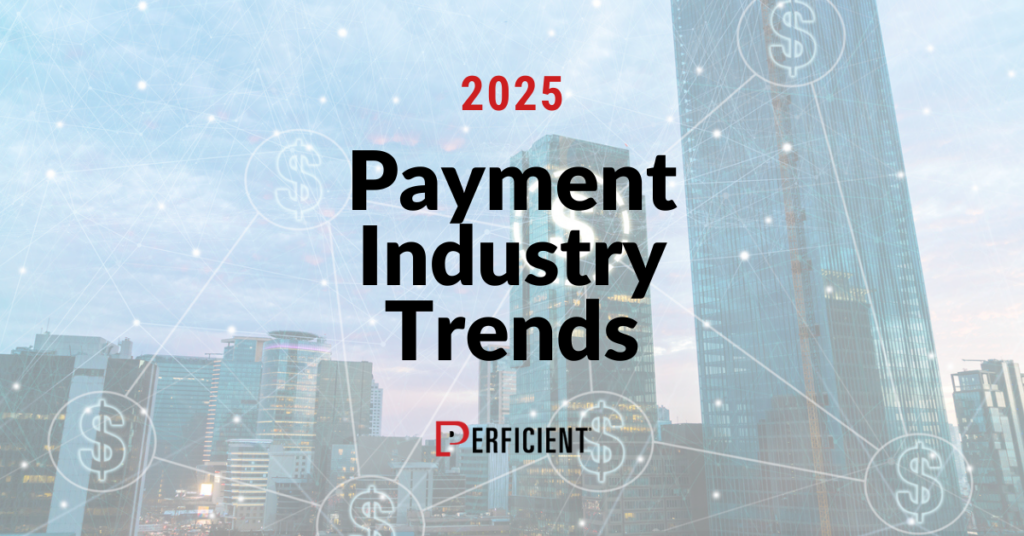The rapidly evolving payments industry is driving industry leaders to adapt their strategies in response to emerging trends. As technology advances and consumer expectations shift, staying ahead of these trends is crucial for success.
Payments Trend #1: AI-Driven Payment Innovations
The landscape of payments and financial services in 2025 will be marked by groundbreaking innovations and user-centric designs powered by Generative AI (GenAI). The industry faces numerous challenges, including protecting sensitive data, navigating evolving regulations, and outdated legacy systems. As these AI technologies evolve, they will transform consumer interactions with payment systems, fostering a more inclusive and sustainable financial ecosystem. This transformation will require a delicate balance between innovation and compliance, ensuring that advancements in AI contribute to a secure and efficient payments landscape.
Recommended Approach: GenAI can assist various payment processes by creating personalized and tailored payment experiences through loyalty programs, discounts, and curated product recommendations. Additionally, AI can enhance accessibility and mobile development through voice and conversational payments, improving user experience. The conversational nature of GenAI will be crucial in making transactions seamless and frictionless for consumers. To harness AI’s potential effectively, it’s essential to develop a strategy that considers payment regulations to ensure consumer protection, data privacy, and ethical use of AI. The future of payments promises not only enhanced efficiency and security but also personalized experiences that align with broader societal values.
Explore More: Transforming Industries, Powering Innovation
Payments Trend #2: The Rise of Real-Time Payments
Real-time payments in the US are expected to see widespread adoption across various sectors, driven by the integration of embedded finance, enhanced biometric authentication, and improved accessibility for consumers and businesses. Traditional payment methods like checks and ACH transfers are likely to decline, especially in business-to-business transactions. Consumers are increasingly using mobile wallets and embedded payments in non-financial platforms, while businesses are leveraging the momentum of business-to-business real-time payments facilitated by networks like FedNow. However, the payment industry encounters challenges such as user education and awareness, integration complexities across platforms and financial institutions, and ongoing regulatory considerations.
Recommended Approach: Payment companies should adopt and expand real-time payment solutions, leveraging networks like FedNow and RTP. Embracing advanced security features such as biometric authentication will enhance user experience and protect data. Ensuring inclusivity and accessibility for all consumers, including those underserved by traditional banking systems, is crucial. Additionally, businesses should explore new revenue models through premium features and address integration complexities with robust data governance and analytics. By focusing on these key areas, companies can effectively manage the challenges and opportunities presented by the widespread adoption of real-time payments.
Success In Action: Ensuring Interoperable, Compliant Real-Time Payments
Payments Trend #3: Navigating the New Regulatory Landscape
The payment industry faces drastic regulatory changes driven by the new administration. Ongoing changes to regulators, protocols, and best practices may have a lasting impact on nonbank financial companies (NBFCs), banks, fees, buy now, pay later (BNPL) services, payment apps, and digital wallets. These changes require significant adjustments in risk management, compliance frameworks, and operational protocols. Enforcing consumer protections will become a gray area, creating operational headaches for consumers and financial institutions. Additionally, the Consumer Credit Control Act (CCCA), currently under consideration, could have significant implications for payment providers. These regulatory changes impact banks and their third-party partners, requiring reassessment of partnerships and compliance strategies. Overall, companies need to adapt to these changes, leading to higher compliance costs, operational expense, and cultural shifts to thrive.
Recommended Approach: To navigate these changes, businesses must balance innovation with compliance. AI will be pivotal in this transition, enabling automation of key compliance processes such as know your customer (KYC) and anti-money laundering (AML) checks. Additionally, AI’s capacity for real-time transaction monitoring and fraud prevention will help companies stay ahead of evolving regulatory demands. The fintech industry, once celebrated for its agility and innovation, now faces a future shaped by heightened regulation. Leveraging AI-driven compliance solutions will be essential for managing global operations effectively in this increasingly complex landscape.
Related: 1033 Open Banking Mandate Blueprint for Success
Payments Trend #4: Optimizing Payment Orchestration Platforms
Payment orchestration platforms (POPs) are poised to play a critical role in the evolving payments landscape in 2025, driven by technological advancements, regulatory changes, and shifting consumer demands. The growth of cross-border transactions, fueled by global e-commerce expansion, necessitates platforms that can handle multiple payment methods, currencies, and compliance requirements. Advanced analytics and AI integration are becoming essential for improving transaction success rates, fraud detection, and overall business intelligence. Additionally, regulatory developments will shape the operation of POPs, aiming to enhance security and reduce fraud. Emerging regions like Asia-Pacific, Africa, and Latin America are key growth areas, with partnerships enabling access to local payment methods.
Recommended approach: To navigate this trend, payment institutions should focus on several strategies. POPs market consolidation is leading to more robust, full-stack solutions that integrate orchestration capabilities into broader platforms. Embracing advanced analytics and AI tools will be crucial for optimizing payment processes and enhancing customer experiences. Institutions should also prioritize the implementation of smart checkout experiences to improve authorization rates and streamline payment options. Staying up to date with regulatory developments and ensuring compliance with new regulations like the third(PSD3) in the EU and the role of central bank digital currencies (CBDCs) will be essential. Finally, integrating POPs with existing financial services and e-commerce platforms will modernize legacy systems and provide more seamless payment experiences, ensuring institutions remain competitive in the digital economy.
Success In Action: At the Heart of Financial Services
Payments Trend #5: The Rapid Adoption of Embedded Payments
Embedded payments are rapidly evolving, and 2025 will mark a major turning point for their adoption in the U.S. Businesses and consumers demand faster, more seamless transactions, driving the expansion of embedded payment solutions across industries. While e-commerce and fintech have been early adopters, industries such as healthcare, manufacturing, real estate, and B2B services are now integrating payment capabilities directly into their platforms. Expect more ERP systems, procurement platforms, and business management tools to embed payment functions, reducing reliance on third-party processors. As embedded payments become mainstream, U.S. regulators will tighten compliance requirements around data security, AML, and consumer protection.
Recommended Approach: Companies must meet evolving KYC and compliance standards, fostering trust and security in digital transactions. Beyond payments, businesses should integrate lending, insurance, and investment options directly into their platforms through embedded finance. Partnering with Banking as a Service (BaaS) providers will allow companies to offer customers seamless access to financial products without switching platforms, further blurring the lines between traditional banking and digital platforms. Additionally, adopting tokenized payments, stablecoins, and decentralized finance (DeFi) integrations within embedded payment systems will be crucial. With Apple Pay, Google Pay, and PayPal leading the charge, expect an increase in one-click, biometric, and voice-activated payments built into everyday digital experiences. Companies that fail to integrate seamless payment experiences risk losing customers to competitors offering faster, frictionless transactions.
You May Also Enjoy: Getting Started On Embedded Finance
Payments Trend #6: Crypto and Payments Intersect
In 2024, crypto made a strong comeback, with Bitcoin surpassing $100,000, driven by its integration into exchange-traded funds. The industry has matured, with blockchain innovations extending beyond crypto enthusiasts and into mainstream finance. Traditional financial institutions are increasingly leveraging blockchain to address complex challenges, while the U.S. continues efforts to regulate and integrate digital assets effectively. Emphasis on security, trust, and usability is essential for blockchain’s success. With these elements in place, financial institutions are embracing blockchain-based solutions, including tokenized money and assets, to enhance efficiency and reduce costs.
Recommended Approach: Companies should explore the coexistence of stablecoins and tokenized deposits. Banks are investigating tokenized deposits, blockchain-based representations of commercial deposits, to enable faster settlements and programmable payments. Meanwhile, stablecoins, pegged to fiat currency, are gaining traction in remittances and business transactions, with approximately $150 billion in circulation. A clear regulatory framework will strengthen their role, leading to an integrated system where tokenized assets and money interact seamlessly. Regulatory clarity will drive adoption, with the U.S. and EU providing models for certainty. Central banks focus on blockchain solutions for financial institutions, enhancing institutional settlements and facilitating faster cross-border capital movement. Interoperability and trust will be crucial, with institutional interest in crypto growing. The future of crypto is no longer speculative, it is becoming a fundamental part of the financial system.
See Also: Be at the Forefront of Innovation
Navigating the Road Ahead
We help payment and fintech firms innovate and boost market position with transformative digital experiences and efficient operations.
- Business Transformation: Create a roadmap to innovate products, enhance experiences, and reduce transactional risk.
- Modernization: Implement technology to improve payment processing, fraud management, and omnichannel experiences.
- Data + Analytics: Proactively leverage integrated data and AI to optimize transactions, manage fraud, and personalize experiences.
- Risk + Compliance: Enhance compliance and risk management to safeguard transactions and customer data.
- Consumer Experience: Deliver convenient, seamless experiences with user-friendly secure payment solutions.
Discover why we have been trusted by 25+ leading payments and card processing companies. Explore our financial services expertise and contact us to learn more.
Source: Read MoreÂ




